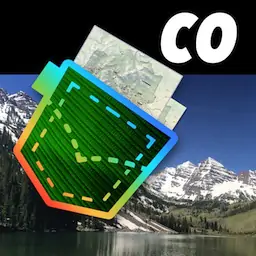by Alex Gugel , all rights reserved
Longs Peak - Keyhole RouteTrail Guides |
Longs Peak - Keyhole Route Trail Guide for Rocky Mountain National Park (NP) in Colorado. Published by the National Park Service (NPS).
featured in
| National Parks Pocket Maps |  | |
| Colorado Pocket Maps |  |
Rocky Mountain
National Park Service
U.S. Department of the Interior
Rocky Mountain National Park
Longs Peak
Keyhole Route
Guide
The Narrows in August
The Keyhole Route to the summit of Longs Peak (14,259 feet) is an extraordinary climbing experience. The route provides stunning views as it circumnavigates the upper mountain on the way to the summit.
For Your Safety
The Keyhole Route Is NOT a Hike
It is a climb that crosses enormous sheer vertical rock faces—often with falling rocks—and
requires scrambling where an unroped fall
would likely be fatal. The route has narrow
ledges, loose rock, and steep cliffs. The terrain
requires good route-finding and scrambling
skills. Use caution, as injuries requiring rescue
are very dangerous and take many hours, if not
days, to evacuate.
Stay on the marked route. Straying from it can
be perilous. The best route follows red and
yellow bull’s-eyes. If you lose the bull’s-eyes
you are likely off-route and will encounter
more difficult climbing with more severe
consequences. It is important to retrace your
steps back to the bull’s-eyes before continuing;
don’t shortcut.
Start Early, Make Good Choices
• Begin your climb no later than 3 am to be
off the summit early in the day. The 15-mile
round-trip takes 10 to 15 hours on average.
• The most important part of your climb is
preparing to safely return. Resist summit
fever: enjoy the experience, but be willing to
turn around at any time.
• Good choices are critical! The toughest
part of the climb up Longs Peak is the last
1.5 miles from The Keyhole to the summit.
Know your limits. If you’re too tired, turn
around. If you don’t feel well or the weather
changes, turn around.
• Stay together—don’t climb alone. Tell
someone where you are going and when you
expect to return.
Pay Attention to Altitude
High elevations can cause altitude sickness
and may aggravate existing health conditions.
Use caution. Take time to acclimatize to the
park’s high altitude before attempting strenuous hikes. Rest, drink lots of fluids, eat salty
snacks, and take progressively longer and more
strenuous hikes. If altitude sickness persists,
descent is the only effective treatment.
Longs Peak’s Weather is Extreme
Before starting your trip, check current conditions online (go.nps.gov/LongsPeak) or with a
ranger (970 586-1206).
The most common snow- and ice-free time
of year is mid-July through mid-September.
However, weather and conditions vary. There
is no way to predict weather on Longs Peak.
The Keyhole Route can have ice, snow, and
winter-like conditions at any time, requiring greater skill and judgment. Be prepared
to quickly turn back during sudden, drastic
weather changes.
Carry Enough Food and Water
Food is your fuel. Pack high-energy snacks.
Eat before, during, and after your climb to
help maintain your energy.
There are no water sources on the Keyhole
Route. Bring at least 3–4 quarts. There are
water sources lower down the mountain, but
they must be properly treated.
Don’t Forget Other Important Gear
33Bring waterproof outer layers and extra
layers for warmth, including a warm hat and
gloves.
33Wear a hat, sunglasses, and sunscreen.
Sunlight can damage your eyes and skin,
even on cloudy days.
33Carry a map and compass or GPS. Know
how to use them.
33Wear sturdy footwear with good ankle support and a treaded sole. Bring extra socks.
33Bring emergency items including a first aid
kit, headlamp or flashlight, whistle, pocket
knife, and emergency fire-starting materials.
33Don’t rely on cell phones. Many areas have
no service.
Visit go.nps.gov/LongsPeak
for more information and
up-to-date conditions
LPK 05-2017
The Keyhole Route (August conditions)
1. The Keyhole from
the Boulderfield
When you reach the Boulderfield, the hiking trail ends. Cross boulder
field terrain to reach The Keyhole, where the climbing route to the
summit begins.
2. The Ledges
From The Keyhole, find the first of a series of red and yellow bull’seyes marking the best route to and from the summit. Travel across
a series of very narrow ledges along a cliff edge. Carefully climb a
constricted slot-like section with two iron bars drilled into the rock.
Continue up toward the high point along the Ledges section. Then
follow a gradually descending traverse to the base of The Trough.
Take note of the Ledges/Trough junction, as some climbers have had
difficulty locating this point while on the descent.
3. Looking down on
The Trough
Continue up to the broad gulley called The Trough. This section is full
of loose rock. Be careful of other climbers and rockfall. At the top of
The Trough, you will come to a short steep section. Carefully climb this
section to the start of the Narrows.
4. The Narrows
The Narrows crosses a sheer vertical rock face on a narrow ledge. A
series of boulders and hand holds will assist you on this constricted
ledge. Continue to the base of the Homestretch.
5. The Homestretch
The Homestretch is a polished granite slab that guards the summit.
This section requires scrambling with your hands and feet and can
have ice and snow throughout summer. Although there are many options, the bull’s-eyes generally provide the best route to the summit.
6. The Summit
Once you’ve reached the summit, you’re halfway on your journey.
Take a moment, have a snack, and catch your breath. Make sure you’re
off the summit early in the day. Although possible any time, afternoon thunderstorms are likely in the summer months and will greatly
increase the difficulty and time required to descend. Remember to use
caution and stick to the route. Most accidents occur on the way down.


